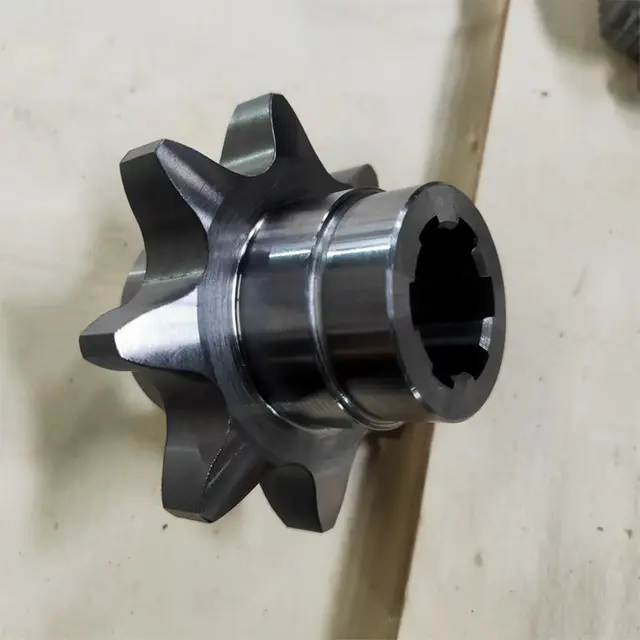CNC Machining In The Automotive Industry
Application Scenarios
Engine Component Machining
CNC machining technology plays a key role in the manufacture of engine components. It is capable of producing components such as engine heads, blocks, crankshafts, camshafts, pistons, valves and connecting rods with extreme precision. These components require a high degree of precision and complexity to ensure optimized engine performance and safety.
Transmission Component Machining
CNC technology is critical in the production of driveline components such as transmissions, gears, driveshafts and clutch components. These components require precision machining to ensure efficient power transmission and a smooth ride.
Suspension Machining and Steering Component Machining
Suspension and steering system components such as control arms, tie rods, ball joints, steering knuckles, and wheel hubs are CNC machined for high precision and strength to ensure ride stability and handling.
Brake Component Machining
CNC machining plays an important role in the production of brake system components, including brake calipers, brake discs, brake brackets and brake master cylinders. Precision machining of these components is critical to providing reliable and consistent braking performance.
Exhaust Component Machining
CNC technology is used to manufacture exhaust system components such as exhaust manifolds, headers, catalytic converters and mufflers to optimize exhaust flow, reduce back pressure and improve engine performance.
Automotive Trim Machining
CNC machining technology is equally important in the manufacture of interior and exterior automotive trim parts, including dashboard components, door handles, trim panels, grilles, logos and decorative details. It creates intricate designs and fine details that enhance the aesthetics and functionality of the vehicle inside and out.
Customized Modifications
CNC machining allows for precise modifications or adjustments to existing automotive components or systems to meet specific performance upgrades, aesthetic enhancements or integration with aftermarket parts.
Chassis and Body Component Machining
CNC technology is used to produce chassis and body components such as frames, brackets, mounting points, structural supports and body panels that require precise machining to ensure proper fit, structural integrity and overall vehicle strength.
Electrical Component Machining
Automation
The automated nature of CNC machining allows automotive companies to manufacture parts without human intervention, allowing manufacturers to focus on innovation and design.
Precision and Accuracy
Technical Advantages
CNC machining produces automotive parts at high speeds because CNC machines rely on computerized instructions and require little human involvement, reducing the impact of human factors such as fatigue on machining operations.
Speed
CNC machining produces automotive parts at high speeds because CNC machines rely on computerized instructions and require little human involvement, reducing the impact of human factors such as fatigue on machining operations.
Repeatability
The high repeatability of CNC machining ensures the consistency of parts in high-volume production, which is critical to guaranteeing that every batch of automobiles meets the same standards.
Case Display

Retaining Ring

Engine Component

Industry Trends
Applications for High-Performance Materials
Automotive component manufacturers are using a variety of technologies to make cars lighter and better performing. For example, the use of lightweight materials such as aluminum instead of traditional materials that are compatible with CNC machining improves the lightness and speed of cars.
Artificial Intelligence in CNC Automotive Manufacturing
The introduction of Artificial Intelligence has enabled CNC machines to self-diagnose faults, increase productivity, and manufacture high-quality parts.
CNC Applications in Self-Driving Cars
Self-driving cars require electrical and mechanical components with the highest surface and functional quality, and CNC machining is important in the manufacture of these parts because of its accuracy, precision and tight tolerances.
FAQs
What is the difference between CNC machining and 3D printing ?
CNC machining is a subtractive manufacturing process that creates the final product by removing parts of the workpiece. 3D printing, on the other hand, is an additive manufacturing process that creates the final product by adding material layer by layer. Both processes are highly accurate, but 3D printing allows for more customization.
What types of CNC machines are used in the automotive industry ?
The types of CNC machines used in the automotive industry depend on the complexity of the part. Simple parts can be machined using any CNC machine, while complex parts such as gearboxes may require advanced 4- or 5-axis machines.
What materials are used for automotive CNC machining ?
CNC machining is compatible with a wide range of materials, including metals (e.g., aluminum, brass, stainless steel, alloy steel, etc.), plastics (e.g., ABS, PEEK, polycarbonate, PTFE, nylon, etc.), wood, foam, and composites. There are also more difficult materials such as titanium, which are suitable for CNC machining but require special cutting tools.

